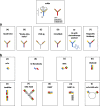Bi-specific and tri-specific antibodies- the next big thing in solid tumor therapeutics
- PMID: 30249178
- PMCID: PMC6154901
- DOI: 10.1186/s10020-018-0051-4
Bi-specific and tri-specific antibodies- the next big thing in solid tumor therapeutics
Abstract
Antibody-based therapy has revitalized the world of cancer therapeutics since rituximab was first approved for the treatment of Non-Hodgkin's Lymphoma. Monoclonal antibodies against cancer antigens have been successful strategies for only a handful of cancer types due to many reasons including lack of antibody specificity and complex nature of tumor milieu which interfere with antibody efficacy. Polyspecific antibodies are promising class of anti-cancer agents which can be directed at multiple tumor antigens to eradicate tumor cells more precisely and effectively. They may overcome some of these limitations and have already changed treatment landscape for some malignancies such as B cell acute lymphoblastic leukemia. Pre-clinical studies and early phase clinical trials have demonstrated that this approach may be an effective strategy even for solid tumors. This review focuses on the development of bispecific and trispecific antibody therapy for the treatment of solid tumor malignancies and highlights the potential they hold for future therapies to come.
Keywords: Bispecific antibody; Immunotherapy; Solid tumor; Trispecific antibody.
Conflict of interest statement
Ethics approval and consent to participate
Not applicable.
Consent for publication
Not applicable.
Competing interests
The authors declare that they have no competing interests.
Publisher’s Note
Springer Nature remains neutral with regard to jurisdictional claims in published maps and institutional affiliations.
Figures



Similar articles
-
Targeting B Cell Maturation Antigen (BCMA) in Multiple Myeloma: Potential Uses of BCMA-Based Immunotherapy.Front Immunol. 2018 Aug 10;9:1821. doi: 10.3389/fimmu.2018.01821. eCollection 2018. Front Immunol. 2018. PMID: 30147690 Free PMC article. Review.
-
Treatment of Hodgkin's disease with bispecific antibodies.Ann Oncol. 1996;7 Suppl 4:143-6. doi: 10.1093/annonc/7.suppl_4.s143. Ann Oncol. 1996. PMID: 8836426 Review.
-
Cure of disseminated xenografted human Hodgkin's tumors by bispecific monoclonal antibodies and human T cells: the role of human T-cell subsets in a preclinical model.Blood. 1996 Apr 1;87(7):2930-7. Blood. 1996. PMID: 8639913
-
When three is not a crowd: trispecific antibodies for enhanced cancer immunotherapy.Theranostics. 2023 Jan 22;13(3):1028-1041. doi: 10.7150/thno.81494. eCollection 2023. Theranostics. 2023. PMID: 36793863 Free PMC article. Review.
-
Monoclonal Antibodies, Bispecific Antibodies and Antibody-Drug Conjugates in Oncohematology.Recent Pat Anticancer Drug Discov. 2020;15(4):272-292. doi: 10.2174/1574892815666200925120717. Recent Pat Anticancer Drug Discov. 2020. PMID: 32981510 Review.
Cited by
-
The Antitumor Activity of TCR-Mimic Antibody-Drug Conjugates (TCRm-ADCs) Targeting the Intracellular Wilms Tumor 1 (WT1) Oncoprotein.Int J Mol Sci. 2019 Aug 12;20(16):3912. doi: 10.3390/ijms20163912. Int J Mol Sci. 2019. PMID: 31408937 Free PMC article.
-
Non-cellular immunotherapies in pediatric central nervous system tumors.Front Immunol. 2023 Oct 11;14:1242911. doi: 10.3389/fimmu.2023.1242911. eCollection 2023. Front Immunol. 2023. PMID: 37885882 Free PMC article. Review.
-
Targeting CLDN18.2 by CD3 Bispecific and ADC Modalities for the Treatments of Gastric and Pancreatic Cancer.Sci Rep. 2019 Jun 10;9(1):8420. doi: 10.1038/s41598-019-44874-0. Sci Rep. 2019. PMID: 31182754 Free PMC article.
-
Targeting the IGF-Axis for Cancer Therapy: Development and Validation of an IGF-Trap as a Potential Drug.Cells. 2020 Apr 29;9(5):1098. doi: 10.3390/cells9051098. Cells. 2020. PMID: 32365498 Free PMC article. Review.
-
Multispecific Antibodies Targeting PD-1/PD-L1 in Cancer.BioDrugs. 2025 May;39(3):427-444. doi: 10.1007/s40259-025-00712-6. Epub 2025 Mar 19. BioDrugs. 2025. PMID: 40106158 Review.
References
-
- Abbasi J. Amid FDA approval filings, another CAR-T therapy patient death. JAMA. 2017;317:2271. - PubMed
-
- Baumann K, Pfisterer J, Wimberger P, et al. Intraperitoneal treatment with the trifunctional bispecific antibody Catumaxomab in patients with platinum-resistant epithelial ovarian cancer: a phase IIa study of the AGO study group. Gynecol Oncol. 2011;123:27–32. doi: 10.1016/j.ygyno.2011.06.004. - DOI - PubMed
Publication types
MeSH terms
Substances
Grants and funding
LinkOut - more resources
Full Text Sources
Other Literature Sources

